



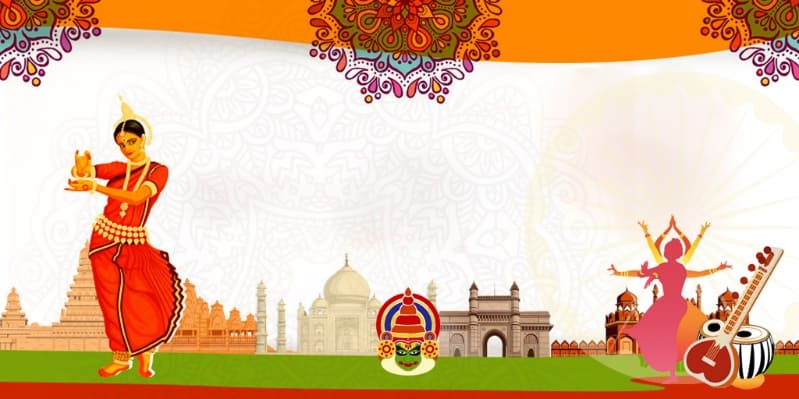
Disclaimer: Copyright infringement not intended.
Introduction
In addition to economic and military power, the idea of Soft Power has gained traction during the past few decades. Indian arts, culture, yoga and spiritualism, culinary varieties, festivals, music and dance forms etc, have attracted people from all around the world for centuries. The Committee on External Affairs has recently presented its Sixteenth Report on the prospects and limitations of India’s Soft Power and Cultural Diplomacy. The committee has recommended that a policy document should be prepared on India’s soft power projections along with a Soft Power Matrix for evaluating soft power outcomes. In its report the parliamentary committee also highlighted the need for greater synergy among Ministry of External Affairs and other Ministries, Departments and agencies involved in India’s soft power projections and cultural diplomacy.
What is Soft Power?
Soft Power is a country’s ability to influence the preferences and behaviours of various actors in the international arena (states, corporations, communities, publics etc.) through attraction or persuasion rather than coercion.
A defining feature of soft power is that it is non-coercive; the currency of soft power includes culture, political values, and foreign policies.
It is defined as a persuasive approach to international political relations, involving the use of a nation’s cultural, historical and diplomatic influence.
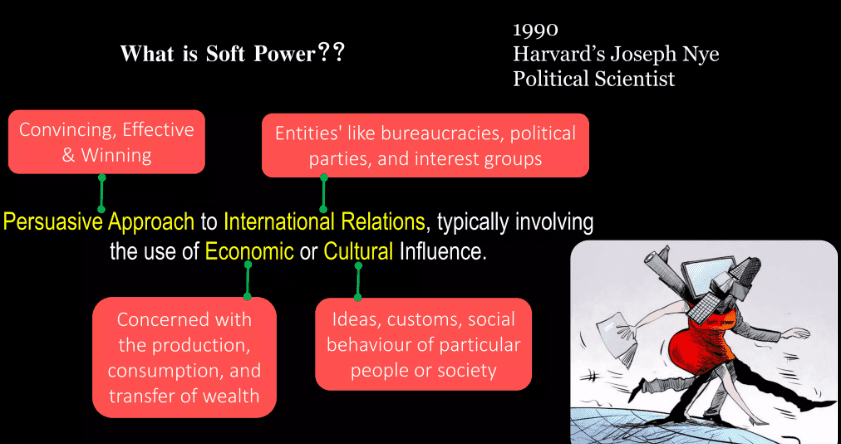
Hard Power Vs Soft Power
The term Hard Power is defined as a coercive approach to international political relations, one that involves the use of military and economic power to influence or control the behaviour or interests of other states or political groups.
Thus, states with a strong military and economic capacity will generally wield their influence on states that are not so powerful in such capacities. According to Harvard political scientist Joseph Nye describes this term as “the ability to use the carrots and sticks of economic and military might to make others follow your will.” This means that stronger countries will exert influence on weaker states through the reduction of trade barriers, offering military security or any other beneficial offers (“carrots”). Likewise, they may also influence such countries through the use of threats such as imposing economic sanctions, trade restrictions, military intervention and use of force (“sticks”). The resounding theme of Hard Power is coercion.
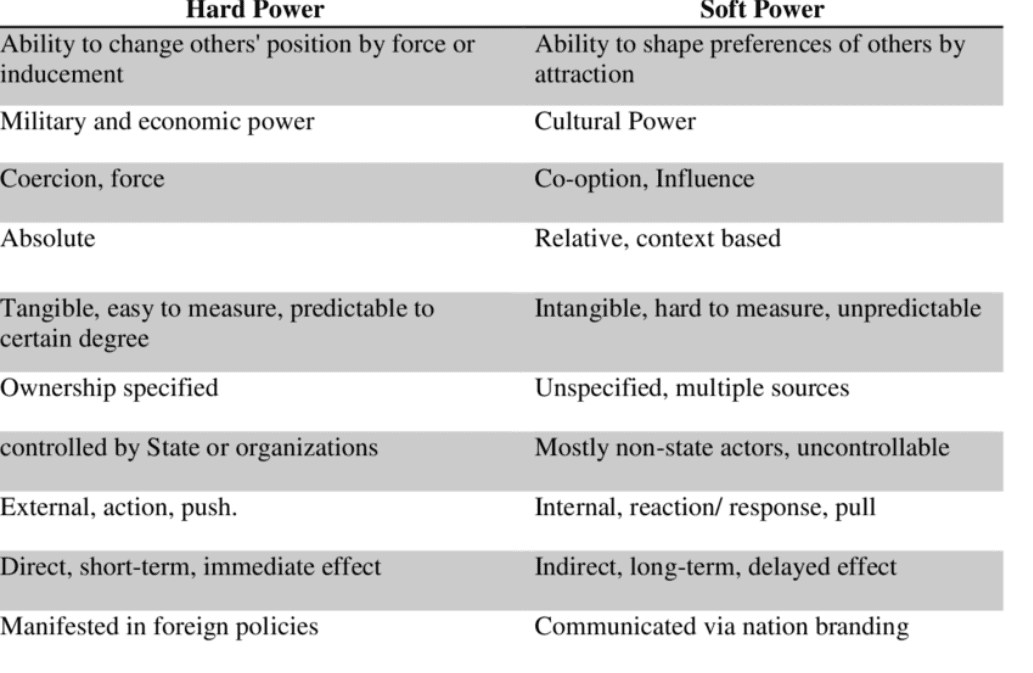
Soft Power, in contrast, represents a subtle, persuasive approach to international relations between states. States utilize Soft Power to “attract and co-opt” other states to desire what they desire. It has the ability to influence the preferences and interests of other states. This persuasive approach is applied through cultural, historical and/or diplomatic means.
Genesis of the Concept of Soft Power
The concept of soft power was introduced in the 1980s by Joseph Nye of Harvard University. He further elaborated on it in his seminal book, Soft Power: The Means to Success in World Politics, in 2004. Essentially, what Nye stressed was that unlike hard power, such as defence capabilities which intimidate, and economic prowess which incentivizes profits, soft power succeeds by shaping the preferences of others through the more intangible tools of appeal and attraction. He didn’t posit soft power against hard power. Countries, he argued, need both, as indeed India does too. Soft power has emerged in the post-Cold War era as a crucial component of foreign policy.
Pillars of Soft Power
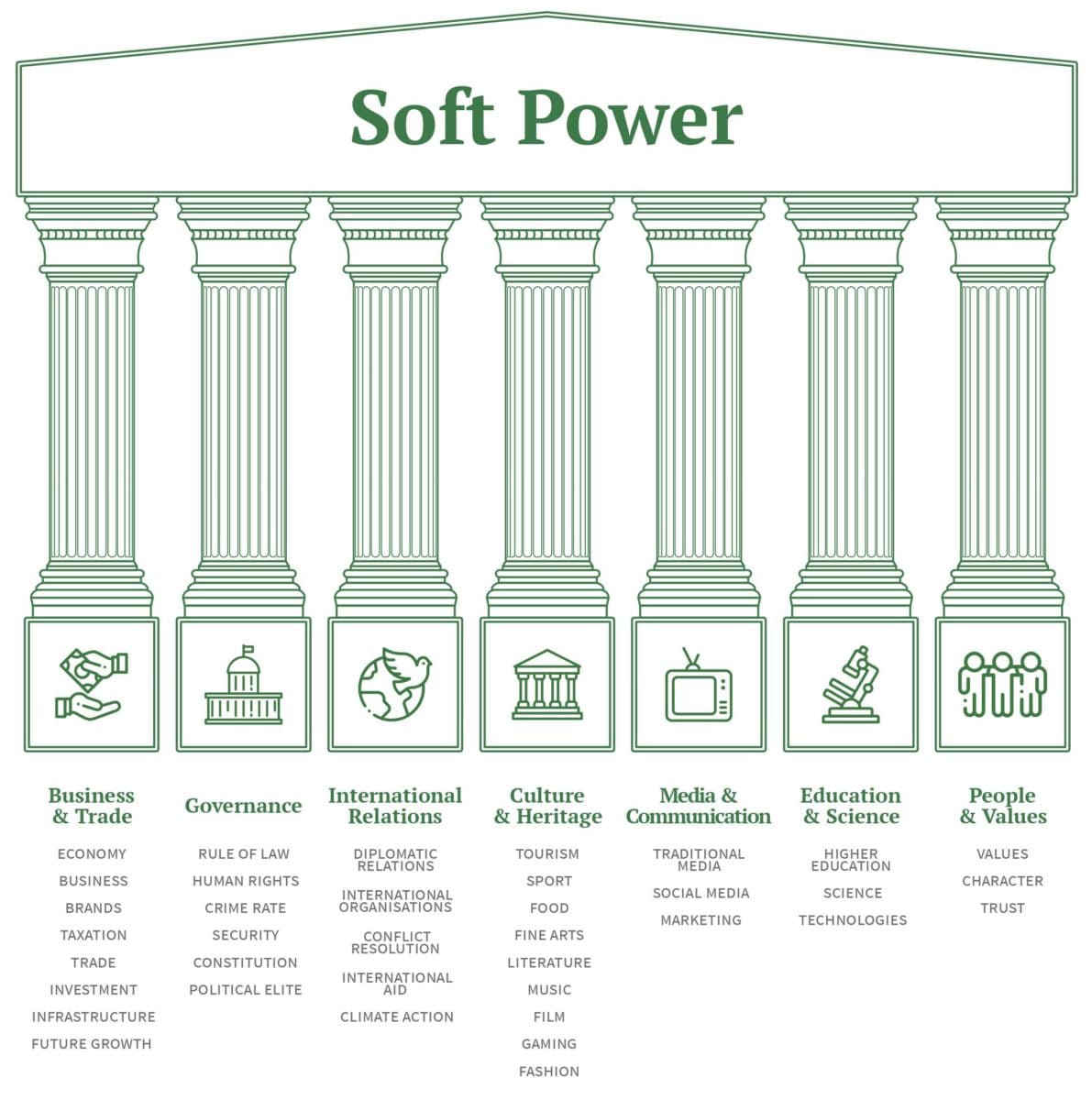
Benefits of Soft Power & A Strong Nation Brand
Experts agree that soft power delivers all kinds of benefits for nations, their people, businesses, and organisations of all shapes and sizes. A strong nation brand and positive soft power perceptions allow a nation to promote itself as a place for people to visit, invest in, and build a reputation for their quality of goods and services. It also allows a country to rise in the esteem of its neighbours, market its resources and compose the face it presents on the international stage.
However, it is often overlooked that a strong nation brand and soft power can deliver better outcomes at home. Primarily it encourages domestic tourism, the consumption of domestic goods and services (rather than imports). Less tangibly it also just makes people feel better about their country. The benefits are extensive, for both the nation and its citizens, domestically and internationally
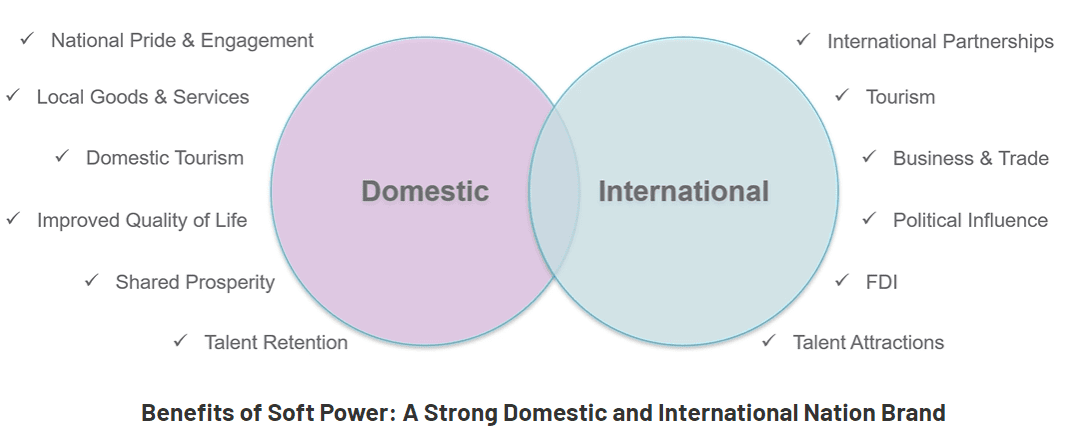
Tracing the roots of India’s Soft Power
During his invasion of India in the 4th century BCE, Alexander the Great had an amazing interaction with some Jain philosophers. According to Arrian, the conqueror’s biographer, Alexander asked the sages why they were not being suitably deferential to him.
In response he received the following reply, also quoted by Amartya Sen in his book, The Argumentative Indian. ‘King Alexander, every man can possess only so much of the earth’s surface as this we are standing on. You are human like the rest of us, save that you are always busy and up to no good, traveling so many miles from your home, a nuisance to yourself and to others! … You will soon be dead, and then you will own just as much of the earth as will suffice to bury you.’
The Jain thinkers may not have known it, but in that reply, they laid the foundations of India’s enduring soft power. To give such a fearless reply to the mighty Alexander, unafraid of the consequences, was a blow for the courage of conviction, the cerebral insouciance, and the freedom of expression that we’ve always valued.
The Historical Context of India’s Soft Power
As an ancient civilization, India has influenced cultures both east and west of it for millennia, and in turn, over the centuries, India has assimilated ideas from foreign cultures, most notably Islamic and European. The roots of India’s soft power run deep. Its civil society has, over millennia, offered religious freedom to Jews, Parsees, Christians and Muslims. Jewish populations have lived on the west coast of southern India since Roman times: Christians claim that St. Thomas visited India soon after Christ was crucified and is buried there. There are more Muslims in India than in Pakistan—the first modern state built on the basis of religion. Home to one of the world’s oldest surviving civilizations and religions—Hinduism—and Buddhism, its biggest ideological export, India’s spiritual, artistic, and cultural impact makes its soft power global. Indian ideas have traveled across the globe—from the peaceful spread of Buddhism across Asia to the Gandhian message of nonviolence in the twentieth century—enriching and exchanging other cultures but also absorbing and assimilating. At the heart of these exchanges was a quest for knowledge and coexistence, as exemplified by Nalanda University in eastern India, a Buddhist monastic center of learning from about AD 427 to AD 1200. It attracted students and scholars from all over India and beyond—from Greece and Persia in the West to Tibet, Korea, and China in the east, until the twelfth century, when the Turks who ruled northern India destroyed it as promoting idol-worship.
India’s civilizational connect, however, was never a consequence a war or colonization, but rather an outcome of exchange of ideas, traditions and culture that accompanied trade of various goods
India has the global recognition of a “non-aggressor country, whose vision is inclusive and whose worldview rests in the idea of Vasudhaiva Kutumbakam – the world is one family.” Diversity of lifestyles, yet a coherent and shared identity and harmony between humans and nature are hallmarks of this philosophy. The Indian civilizational thought is rooted in the idea of co-existence with mother nature rather than conquering it. In this sense, the practice of soft power is embellished in India’s core identity that dates back to millennia, even though the term is comparatively new in the foreign policy and cultural discourse
Soft Power in the Modern Times
In the modern world, soft power has two key components, culture and political values. The attraction of a nation’s culture is, of course, easy to understand, and India, as an ancient civilisation, has a huge treasure house of cultural assets. But, even more importantly, India is respected for its values of democracy, openness, diversity of thought, respect for all religions and freedom of expression.
India’s soft power calling card to the world is that, along with its rich cultural inheritance, it’s the world’s largest practicing democracy. In this sense, the Indian experience is unique compared to most other formerly colonised developing nations, or newly emergent superpowers like China, which are seen as autocratic. The appeal of India is that it’s a working laboratory for the success of inclusive democracy against all odds.
India is a pluralist and benign country and is expressed as the culture of pluralism in four domains: religious (Buddhism and Sufism), social (yoga), political (democracy), and economic (innovation and entrepreneurship).
India is a culture-driven soft power. One example is the availability and appreciation of Indian cinema as a source of recreation in the conflict-ridden Afghanistan. Another major cultural export is Indian gastronomy, be it turmeric latte sold in cafés, jackfruits used in gourmet preparations or the Australian PM Scott Morison’s display of Samosa diplomacy.
Arts, fashion and handicrafts, literary works, and performing arts and tourism are other key aspects of Indian soft power. To realize and maximize the potential of such traditions and practices, it is important to develop a robust cultural creative economy, giving more and more opportunities for creative entrepreneurs to take Indian culture across the globe. This can also lead to cross-cultural cooperation and mutual learning between cultural experts, entrepreneurs and enthusiasts from across the world.
The soft power of a country is when its cultural assets become a subject of aspiration and admiration by the global community. India is blessed with immense cultural assets, be it Yoga, Ayurveda, literature, arts, heritage, culinary practices, sports and much more, along with being the largest democracy and, having strong institutions and leaders. When the propagation of soft power is done with the idea of fostering mutual respect, shared understanding and joint collaborations for cultural advancements between countries, it becomes the essence of cultural diplomacy.
Beyond cultural and civilizational heritage, India has been recognized for its role in addressing global challenges and being at the forefront of various development-related initiatives. Though India’s international engagement is guided by its security and strategic interests, it is also underpinned by the values of inclusivity, plurality and welfare for all. The establishment of International Solar Alliance, for example, demonstrated India’s commitment towards mitigating environmental risks through multilateral cooperation. Similarly, India offers humanitarian aid to smaller mainland and island economies in times of calamity, while its contributions to the UN Peacekeeping forces are amongst the highest in the world. The country’s cooperation at bilateral and multilateral forums for fighting COVID-19 through supplying hydrochloroquine to the world as well as directing R&D efforts towards vaccine development highlight India’s contribution in the global pharmaceutical and wellness sector. Under the vaccine 'Maitri' initiative, India has supplied over 235 million total supplies of COVID-19 vaccines to 98 countries of the world.
Owing to these and many other contributions towards the greater good for all, India is ranked 44th out of 160 countries in the Good Country Index (GCI). Speaking on the theme India’s Global Connect at Namaste 2020, Anholt, the creator of Good Country Index explained that the ‘goodness’ of a country is determined by its multilateral engagement and cooperation in addressing common global challenges.
Higher levels of involvement build positive perceptions about the country that in turn invite greater foreign investment and visitors, thus contributing to the country’s soft power and reputation in the eyes of common citizens.
As Shashi Tharoor observes in his 2012 book Pax Indica, India is an enthusiastic proponent. India draws on its rich cultural traditions, including Bollywood movies, yoga, Ayurvedic medicine, heritage tourism, and distinctive, spice-rich cuisine, to wield soft power diplomacy. The country, which boasts a global diaspora, is also admired for its focus on education, political pluralism, and religious diversity. While in the past India may have been assumed to be a recipient of foreign aid, in recent years it has even become a donor of economic aid to less developed countries.
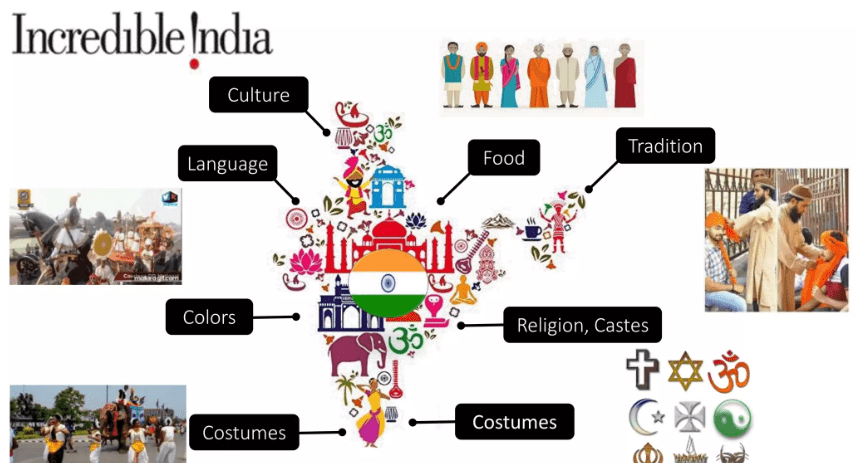
Assets of India’s Soft Power
Indian Cinema
India’s film industry, Bollywood, is the producer of highest number of films in the world and is popular in Afghanistan, Pakistan, Central Asia, the Middle East, South East Asia and in many other parts of the world. Shashi Tharoor accounts how during the peak of violence in Afghanistan in 1990s, people never failed to watch Indian soap opera, Kyun Ki Sass Bhi Kabhi Bahu Thi. He cites another example, in Syria during the regime of Hafez al-Assad, the life size portrait of then Bollywood superstar, Amitabh Bachchan, was as big as of al-Assad.
During the cold war era, film stars like Raj Kapoor worked as bridge between India and other countries. Kapoor and his films like Awara and Mera Naam Joker were immensely popular in Soviet Union. In the Middle East, Indian films run for days, and the diaspora plays an active role in popularizing the films. In countries such as the United States, Hindi films are increasing playing in multiplexes to satisfy demands of increasing Indian diaspora.
The Indian film industry, with Bollywood at its heart, has charmed viewers across the globe. Bollywood cultivates strong ties with the Indian Foreign Ministry. It helps formulate foreign policy, and endeavours to improve India's image abroad by exporting Indian cultural products.
Dance and Music
Along with Bollywood, Indian music and cultural elements such as dance and drama too have played a role in boosting India’s image as a soft power. For instance, the USA-based Bollywood America, annually organizes dance and other cultural events. The aim of the organization is “to celebrate and spread interest in the diversity and tradition of South Asian culture” in the world. The popular memory treasure the friendship of the Beatles with the Indian sitar maestro Ravi Shankar and Yogi Yogananda. And, to add, many Indian actors are becoming part of Hollywood movies as well as television shows.
Gastronomical map
Indian food, another element of the soft power, has become increasing popular in various parts of the world. Indian spices have captured the popular imagination by featuring in films like Mistress of Spices and Today’s Special and a whole host of television shows like Outsourced and The Big Bang Theory for example.
Indian food is one of the UK's great success stories. Every week, 2.5 million customers eat in one of almost 10,000 restaurants employing 80,000 staff, making the industry worth an estimated £3.6 billion.
Sport
Cricket has also proved a strong source of soft power for India. So-called cricket diplomacy has had notable positive effects in reducing Indo-Pakistani tensions. It has also been used as a signal of readiness to negotiate. In 1987, for example, relations between the two countries had reached a critical point. To help lower tensions, Pakistan's President General Zia-ul-Haq visited India to watch an India-Pakistan cricket match.
In 2008, an Islamist terrorist group based in Pakistan carried out coordinated attacks in the Indian city of Mumbai, severely damaging bilateral relations. Three years later, Prime Ministers of both nations met in Mohali, India, to watch the Cricket World Cup semi-finals. High-level diplomatic dialogue followed the meeting, helping diffuse the lingering tension between the two countries.
Religion, culture, and spiritualism
Yoga – 'India’s gift to the world' – is another major soft power tool in India’s armoury which enjoys millions of enthusiastic practitioners worldwide. In 2014, India succeeded in getting 21 June recognised by the UN as World Yoga Day. A potent medium for promoting the Indian way of life, yoga helps project an image of India as a peaceful country that refrains from aggression. In a foreign policy context, harnessing the holistic power of yoga helps cultivate other countries' goodwill.
Buddhism originated in ancient India, from which it spread to China, Southeast Asia and beyond. India uses Buddhist diplomacy to achieve his strategic and economic foreign policy goals. Chief among these goals are offsetting Chinese soft power, and boosting religious tourism in India.
The Indian diaspora
The Indian diaspora, too, is a major asset of India’s soft power diplomacy. In the US, it plays an important role in improving Indo-US relations by lobbying American politicians. It also offers a positive image of India to the American public.
Information Technology has made its own contribution to India’s soft power. When Americans in Silicon Valley speak of the Indian Institute of Technology (IIT) with the same reverence they used to accord to MIT, and when the ‘Indianness’ of engineers and software developers becomes synonymous with mathematical and scientific excellence, it is India that gains respect.
Epics
The epics Ramayana and Mahabharata are compared with Illiad and Odyssey, and Kalidasa, the great Sanskrit playwright and poet, is compared with Shakespeare and Kautilya with Machiavelli. Kautliya’s disciple, Ashoka, once known for his aggressive foreign policy and rule of the sword, later abandoned his aggressive policy and cultivated soft power.
India has been a melting pot of religions, languages and cultures. Sanskrit played an important role in building the identity of India and its soft power. According to Hart (1984: viii), Indian scholars had accumulated some 160,000 texts in Sanskrit since long time. While Sanskrit dominated the landscape for significant part of its history, other languages and religions gradually became an inseparable part of Indian culture and tradition.
Culture And Spiritualism
The Indian culture and spiritualism as enshrined in scriptures such as Vedas and Vedanta aptly encapsulated this diversity. In Chhandogya Upanishad, it is written, “Ekam Sat, Vipra Bahudha Vadanti”—the Truth is one, but the wise speak it in different ways. Similarly, “Sarve Bhavantu Sukhina, Sarve Santu Niramaya. Sarve Bhadrani Pashyantu, Ma Kashchit Dukhbhag Bhavet”—Let everybody be happy, healthy and wise, and let me share their sorrow. Mundaka Upanishad says, Satyameva Jayate (also used in Indian national emblem)—“Let truth emerge victorious”. Indian tradition identifies individual values with universal values, and does not differentiate individuals on the basis of religion, language, race or color. This trait is encapsulated in Sanskrit words “Vasudhaiva Kutumbakam”—the whole world is one family.
When India got independence on 15 August 1947, Sri Aurobindo in his radio message envisioned five dreams for India. The fourth one, “the spiritual gift of India to the world”, read, “India’s spirituality is entering Europe and America in an ever-increasing measure. That movement will grow; amid the disasters of the time more and more eyes are turning towards her with hope and there is even an increasing resort not only to her teachings, but to her psychic and spiritual practice”
Tolerance
The ancient, and traditional, portrayal of the Hindu religion as a tolerant and pluralistic religion has helped India portray itself as a peaceful and tolerant nation. The US Congresswoman, Tulsi Gabbard, argued, “The essence of the Hinduism that I practice is karma yoga and bhakti yoga, which means to love God and all [emphasis hers] of His children, regardless of their race, religion, etc., and to use my life working for the well-being of everyone” (Balachandran, 2016). As Niall Ferguson argued, the role of religion in shaping politics cannot be undermined, and the power of religion and morality may prove more enduring than hard power
Dalai Lama, the spiritual leader of the Tibetans, argued, “India’s long tradition of religions tolerance can be a role model for rest of the world”. He further argued, “major religions of the world like Hinduism, Buddhism, Jainism and Sikhism originated in India and it provided shelter to followers of religions like Zoroastrianism. These can be a model for rest of the world.” All religions and cultures have contributed to the evolution of India’s Soft Power.
There are ample cases in history of how Islam shaped Indian culture. Mughal Emperor Akbar, of 16th Century, conceived a new religion—Din-i-Elahi (Religion of God)—synthesizing the best elements of various religions. There were Saints who bore Hindu and Muslim names. For example, in Kashmir the names Nund Rishi (Hindu name) and Noor-ud-Din (Muslim name) belonged to the same saint. Similarly, there were Saints like Kabir who had both Hindu and Muslim disciples.
Science
Not only in spiritual, religious or cultural field, India’s soft power assets also encapsulated the fields of science. Aryabhata, Bhāskara I, Brahmagupta, Varāhamihira contributed to mathematics and astronomy in the ancient period. It has often baffled the Western mind how great Indian mathematicians and scientists were also devoutly religious. In the Indian conception of science and spiritualism, the line of demarcation is thin. The 2015 Hollywood movie “The Man Who Knew Infinity”, based on the life of the famous Indian mathematician, Srinivasa Ramanujan, displays the connection between science and religion, a characteristic trait of Indian culture and identity.
Gandhiji
One of the most famous ambassadors of India’s soft power was Mahatma Gandhi. Gandhiji made famous the principles of truth and non-violence during his struggle in South Africa, and practiced those in India against the British rule. He inspired thousands of freedom fighters around the world, and gave the call for an “Asian Way” during the Asian Relations Conference in New Delhi in April 1947, when he said, “… the message of the East, the message of Asia, is not to be learnt through European spectacles, through the Western spectacles … If you want to give a message again to the West, it must be a message of ‘Love’, it must be a message of ‘Truth’ ”.
King Jr (2005: 136) referred Mahatma Gandhi as “the guiding light of our technique of nonviolent social change”
In a real sense, Mahatma Gandhi embodied in his life certain universal principles that are inherent in the moral structure of the universe, and these principles are as inescapable as the law of gravitation
Yoga
Among various soft power assets of India, yoga is a prominent one. According to Indian spiritual tradition, it implies union of the individual soul with the divine soul. International yoga Day aims to raise awareness worldwide of the many benefits of practicing yoga. One of the major recognitions of India’s soft power was the United Nations’ approval of 21 June as International Yoga Day. Internationally about 125 million people practice yoga. In 2016, on the yoga day at Dubai, led by Indian yoga guru, Baba Ramdev, 100,000 people participated, creating Guinness Book record. In recent days, there have also been attempts to explore the utility of yoga in bringing peace in conflict situations.
The famous yoga guru and founder of Art of Living Foundation, Sri Sri Ravi Shankar is a strong advocate for applying yoga to realize peace and reconciliation among warring parties in conflict situations around the world. His foundation travelled to conflict situations within India and other countries such as Iraq, Cote d’Ivoire, Cameron and Sri Lanka to promote peace and harmony.
Ayurveda
Besides yoga, Ayurveda (which can be translated as “science of life”), an ancient practice, is another Indian soft power tool. Ayurveda is one of the branches of the Vedas. Ayurveda has become increasingly popular in the developed world, and it is seen in conjunction with yoga. At present, there are about 2000 Ayurvedic Retreat centers around the world, and out of which about 100 centers are based in the United States.
Association of Ayurvedic Professionals of North America (AAPNA) aims to bring “the healing science of Ayurveda and its modalities to the forefront of integrative medicine in the West”. In November 2014, Indian government upgraded the Department of Ayurveda, yoga and Naturopathy, Unani, Siddha and Homoeopathy, founded in November 2003, into a full-fledged ministry.
Limitations in growth of India’s Soft Power
Despite being the largest democracy and having a rich culture, India was plagued by impoverishment, missing out on positive associations, coupled with lack of investment in cultural diplomacy, a reputation of deep-rooted corruption, hostile business environment, red tapism, lack of infrastructure and severe pollution in urban areas. As a result, India was missing out on its due place on the high table at the world forums with limited sphere of influence which was not in synch with its global aspirations. Benign, nonaggressive impressions along with inability of the Indian state to be effectively governed and to deliver a quality life to its citizens has had an adverse impact on the national image.
According to Portland’s ‘soft power 30’, India doesn't even make the top 30 countries that excel in this sphere.
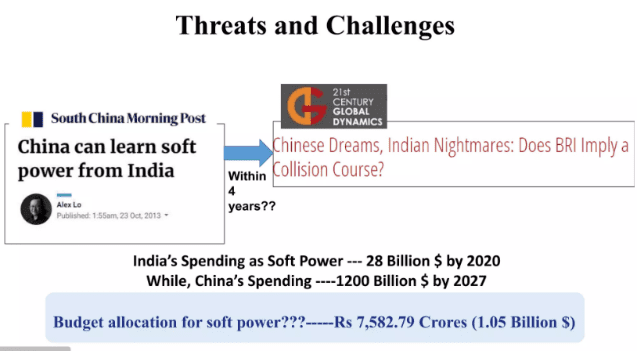
Manifestations of India’s Soft Power
Despite the evident shortcomings—India has a reasonably good track record of leveraging its culture, political values and foreign policy for national objectives.
In the 1950s, India benefited from significant aid from both the United States and Soviet Union. Democrats in the U.S. Congress saw India as a darling of the developing world even as Soviet leaders perceived the country as a foothold for their engagement outside the communist bloc. India benefited in very real terms from these associations and relationships, resulting in the establishment of the Indian Institutes of Technology, which formed the backbone of India’s software boom in the 1990s, and the Green Revolution in the 1960s that helped make the country agriculturally self-sufficient
There was also a strong moral streak in India’s external engagement during the Cold War, helped in part by its self-perception as a pluralistic but postcolonial democracy.
In 1959, it was in India that the Dalai Lama sought refuge, and the presence of the Tibetan spiritual leader and his followers in India continues to attract visitors and supporters from around the world.
Similarly, India’s principled boycott of South Africa for its racist Apartheid policies won it respect from post-colonial states across Africa.
In 1971, despite overwhelming opposition from the U.S. and United Nations, India created international acceptability for its intervention in East Pakistan (which resulted in the independent state of Bangladesh) by calling attention to the morality of its actions. It was assisted in no small part by the appeal of Indian culture among the likes of former Beatles member George Harrison, who organized a sold-out concert for Bangladesh in New York’s Madison Square Garden that featured Eric Clapton and Bob Dylan, and helped bring acceptability to India’s military intervention and creation of an independent state.
India’s soft power appeal manifested itself even after the end of the Cold War. In the 1990s, India was brought into Asian institutions by the Association of Southeast Asian Nations (ASEAN), which saw the appeal of its growing economy and democratic values.
Similarly, in the 2000s, the U.S. worked to gain India an international waiver from nuclear sanctions, effectively recognizing it as a de facto nuclear weapon state, a process that was enabled by mostly positive associations of India as a democracy, growing market and responsible steward of nuclear weapons.
Even more recently, governments and dissidents in India’s neighboring countries—from Bangladesh and Nepal to the Maldives and Afghanistan—turn to India for assistance in conducting free and fair elections, drafting their constitutions and developing welfare schemes.
As these examples suggest, the metrics of soft power—particularly those that capture state-led efforts, high-end cultural exports or per capita capabilities—may understate India’s record of utilising its soft power for national objectives. India has found soft power to be a necessary but insufficient ingredient in its engagement with the world. As a democracy with a rich culture and a modicum of principle in its international engagement, it has often benefited in real, tangible ways from its soft power. Clearly, though, it has its work cut out in better projecting its culture and values to international audiences.
More innovative uses of soft power more recently
Soft power has been expanded in diverse forms by succeeding governments in India. The present government has been creating innovative trends in the realm of Indian diplomacy by blending contemporary elements of soft power. Today, the state has used specific soft power assets of India such as Diaspora, Yoga, Buddhism and economic support for accomplishing diplomatic triumphs and advancing the nation’s national interests.
India’s Ministry of External Affairs (MEA) has determined to promote a “soft power matrix” to measure the effectiveness of the country’s soft power outreach. The goal of the MEA is going to be an indispensable test condition in the aforementioned regard. Initiatives such as ‘Destination India’ and ‘Know India’ have likewise been launched. Cultural centers like the Indian Council for Cultural Relations (ICCR) even organized a national convention ‘Destination India’ initiative for the first time in 2019 which believes that India can move up fast to be a leader of the global knowledge society. ‘Namaste diplomacy’ and ‘Medical diplomacy’ of India today has become the talk post-COVID-19.
India’s supremacy in space statesmanship and technology is an added principally induced soft power means with endless prospects. India’s regional diplomacy has reached outer space with the nation launching its GSAT-9, also known as the South Asia Satellite, that aimed to bestow South Asian countries with space-enabled services.
As an ancient civilization, India has a throbbing democracy, the largest in the world, a secular spirit and a speedily developing marketplace that grew to become the 5th most booming economy in 2019, overtaking the United Kingdom and France. India, to boost its communication, tourism, culture and soft power, on the whole, will have to forge multilateral and bilateral collaborations with different nations by enhancing its foreign policy and diplomacy.
Due to the attractiveness of India’s culture, social values, and foreign policies in addition to the nation’s economic and military might, India will be better placed to join the rank of Asia’s great powers. India, which is expected to become a superpower by 2025, also possesses soft power advantage having a democratic system compared to China’s communist belligerent system. Since the last ten years, India has likewise elevated its indispensable resources in public diplomacy, by applying traditional and innovative channels to create and anchorage its soft power.
These initiatives are working to leverage India’s soft power “by using it to support larger foreign policy initiatives such as the Look East Policy (now Act East), the Connect Central Asia policy, and developing strategic aid and trade partnerships in Africa.
Way Ahead
The recent abrogation of Article 370 and the response from various countries to our internal decision, bears testimony to the rising soft power influence where besides Pakistan only three countries voiced their dissent to Indian government’s actions. Yet, many cobwebs from decades of inaction need to be cleaned, more broad-based reforms are still needed. With a strong government striving to reach out to all major powers, if we indulge in a policy of do not provoke and nor get provoked, exploit the rising soft power potential of our country fully and concentrate on building up a more vibrant and robust economy, then this could well be an inflection point in India’s rise as a world power.
Some Recommendations to strengthen India’s Soft Power
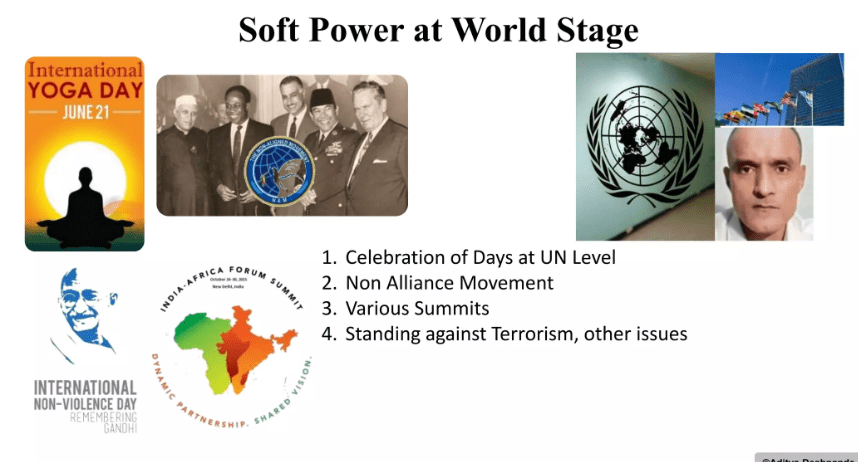
Recent PP Chaudhary-led panel Recommendations
Final Thought
For Indian soft power to achieve its full potential, it is imperative to have an integrated approach that amalgamates public diplomacy at the global level with a creative economy at the local level. This necessitates the involvement of all stakeholders, including artists, entrepreneurs, academics, policymakers and civil society. Namaste 2020: Global Utsava of Indian Soft Power was one such initiative by the Center for Soft Power.
The underlying idea is that in the ongoing contest for soft power in the world where countries increasingly seek to lead and steer conversations around power dynamics, there is an increasing desire and necessity to connect with each other’s culture and communities. But Soft power by itself is no guarantee of security. A balance of soft and hard power is the key.
Soft and hard power both aim at realizing national interests and how far India is able to capitalize on its soft power assets demands scrutiny.
India’s ability to tell a “better story” has not been very effective in delivering desired outcomes notably. The nation’s potential of soft power if implemented certainly would enhance India’s more exalted position, in making it well disposed and flourishing in the world. In the mounting multipolar global order, India definitely has the potential and holds immense opportunities to elevate its position further as the ‘rising global soft power’ that can further pave way for the country to become a ‘soft power-superpower’ of the 21st century.
Citations:
https://sansadtv.nic.in/episode/perspective-indias-soft-power-13-december-2022
https://www.nature.com/articles/palcomms201691
https://www.claws.in/changing-contours-of-indias-soft-power-diplomacy-2/
https://theloop.ecpr.eu/indias-soft-power-diplomacy-in-the-modi-era/
https://thediplomat.com/2015/05/indias-soft-power-potential/
https://uscpublicdiplomacy.org/blog/celebrating-indian-soft-power
© 2025 iasgyan. All right reserved